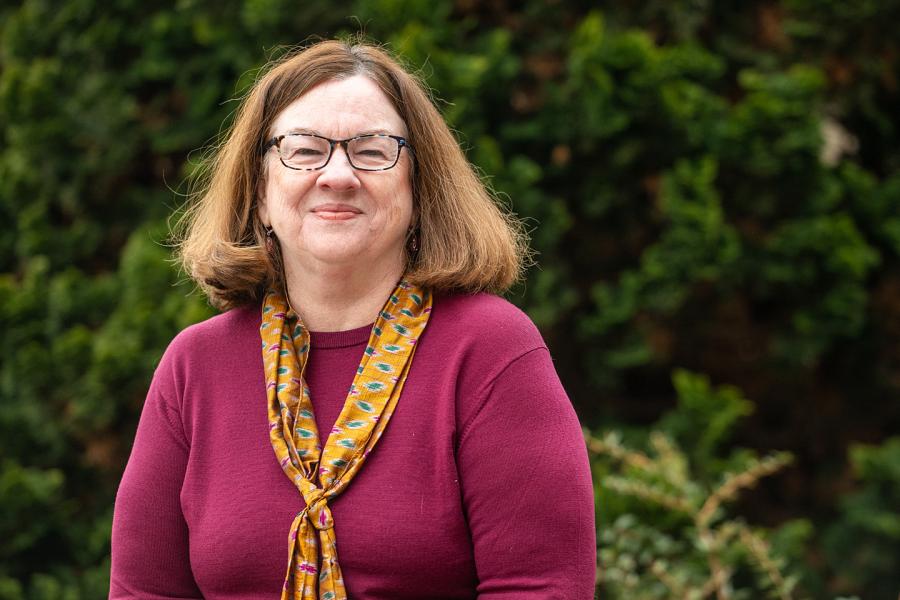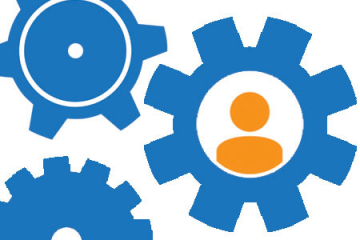Years ago, when Kathy Cahill was contemplating her future, she thought it would be meaningful to do something with—and for—other people. It's one of the reasons she became a geriatric social worker focusing on elderly clients who were homebound. "I really liked it," she recalls. "I liked hearing their stories and about their life experiences."
It's also one of the reasons she ultimately turned her focus to the field of assistive technology, a departure from her previous career as a social worker but similarly rewarding. "I learned early on that access to technology for people with disabilities is crucial," she says, adding that she already had considerable prior experience in computer programming. "I wanted to take my computer skills and put them to use in a helpful way."
Cahill joined Johns Hopkins University in January 2022 after 25 years at MIT, providing assistive technology services to students and staff as well as consulting on digital accessibility. Cahill now serves as JHU's digital accessibility coordinator. In this role, she works to build awareness about digital accessibility by offering training and guidance to university departments and faculty about the most effective ways to make their digital materials accessible to people with disabilities.
She is the person with the technical expertise—the one who can explain what needs to be done, where to find it, and how to do it. "I'm not a programmer, meaning I don't build the technology; I just advise about it," she says. "At the same time, I feel like I'm making a concrete impact."
Cahill came to assistive technology almost by accident. While in social work school, she was looking for a part-time job that used her computer skills. That's when a former boss suggested she check out assistive technology. She had no real experience in the field but was intrigued, drawn to the notion of making computers and digital information usable by people with disabilities so that they could participate in education and the work force.
She sent her resume to several state agencies and was hired—one day a week—by the Massachusetts Commission for the Blind, where she worked as a rehabilitation engineer providing assistive technology installation and training for the commission's clients, adding, for example, "screen readers" (devices that convert text to speech so that a blind user can listen to the information on the screen).
"To do this work, I was mentored by my boss, Joe Lazzaro, who was a self-taught assistive technology whiz, a user of the technology, and an author of books on the topic," she recalls. "He went with me on visits to clients in their homes or workplaces and showed me how to install the assistive technologies; back in the early days of the PC, assistive technologies often had both hardware and software components. Then we would provide some basic training to the clients and make sure that the assistive technology worked with the programs they used. [The experience] opened up a whole new world to me about the benefits and shortcomings of these technologies."
The internet was in its infancy, "and everybody wanted to partake in it," she says. However, "technology was harder to obtain, install, and use back then. In general, computers and programs were harder to use, and so was the assistive technology. A lot has changed. Many applications work more smoothly and predictably [now] than they did in the early days.
For example, in the late 1980s and early 1990s, many blind and visually impaired computer users had MS DOS as the operating system for their computers, she says. "DOS had a command line interface, so it wasn't too hard for a screen-reading program to read the command line prompt and the results from the user's typed commands on the screen," she explains. "After the Windows 3.1 operating system launched in 1992, it presented many more challenges to blind screen-reader users because of its very visual graphical interface that was challenging to navigate."
When installing a screen reader for a client, she says, one had to install hardware (either an external or internal speech synthesizer) as well as software (the screen-reading program) and ensure that the screen-reading program was connected to the speech synthesizer so that the speech output would go to the right device.
Also, blind users often required scanners on their computers to convert paper documents to digital format so the screen reader could "read" them. Moreover, some of the scanners came with separate circuit boards that had to be installed inside the computer. That way, software that performed optical character recognition, or OCR, could change images of text to actual text so that the screen reader could read the material out loud.
Fast forward to now. Software installation programs can be downloaded easily from the internet instead of from diskettes or CDs. The software "is more user friendly and has accessibility features built in," she says. "Assistive technologies can still be quite expensive, but there are options for free screen readers—NVDA, VoiceOver, magnification programs, and other free or low-cost apps. Screen-reading programs and other assistive technologies no longer require extra computer hardware."
Also, the introduction of cameras on cellphones enables users to take a picture of a document and convert it to text with an app, she says. Most operating systems (Mac OS, Windows, iOS, Android) come with such built-in accessibility features, she says.
Cahill still lives in Boston, where she grew up—she describes herself as "super local"—and works remotely from her home. Even as most of JHU has been returning to campus in some capacity, her bosses agreed that she could still perform her duties effectively from afar, since "my job is less one-on-one client-oriented, and more process- and communication-oriented," she says. And she flies to Baltimore when needed to attend meetings and accessibility-related events. "There are so many colleagues here at JHU already doing great work on digital accessibility—IT staff, instructional design staff, faculty, Student Disability Services staff—and it's my job to make sure that we share this information widely so that departments are all able to take advantage of this knowledge. It's also important to include students and colleagues with disabilities in this work because they are the users. It has to work for them."
Her job includes increasing awareness and providing training and services "so that people know what they have to do to make things accessible," she says. "The goal is to encourage a certain baseline of accessibility in the digital materials that the university uses. For instance, if your department provides professional development training in a video format, you have to make sure that those videos are captioned. My job is to communicate the importance of accessibility in the digital materials the department creates."
Cahill received a bachelor's degree in business management from the University of Massachusetts at Boston, followed by a master's in social work from Boston College. Her husband does estimates for a company that performs high-end renovations. One of their two sons is a junior at Drexel University in Philadelphia, and their other son recently left his job as a technical writer for a Boston area software company to become a downhill ski instructor in Washington state.
She made the switch to JHU from her longtime MIT job feeling that "after the pandemic, it was time for a change. MIT was the only university I had worked at, and I was curious how this work was being done elsewhere. I was excited to join a university with schools of medicine, education, and public health and to think about the connections between accessibility and those disciplines. I've been impressed with JHU staff's knowledge of digital accessibility and their efforts to implement good digital accessibility practices in their areas."
Earlier this year, Cahill and her colleagues revised the JHU Digital Accessibility website to provide more detailed information on best practices, as well as links to trainings and how to create accessible materials in various file formats. "We are also working to provide some virtual accessibility open office hours to answer people's questions about issues they may be having in making materials accessible," she says.
"I would love for people to realize that it's not that hard to make their digital materials accessible," she adds. "Taking the time to learn what digital accessibility is and why it's important goes such a long way in creating a welcoming digital environment for people with disabilities. Creating accessible emails, documents, posters, course materials, and websites means that you are practicing inclusion so that everyone has access to the important information that JHU shares with the world."
Posted in News+Info
Tagged who does that?









